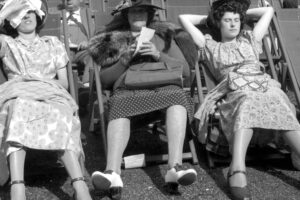People have been asking us what kind of world we think we are living in today. We find it almost impossible to answer that question. To answer this question, we believe we must first ask what have we become as a society.
Looking back years ago to WW2, the country sacrificed countless lives and during that time enjoyed fewer comforts. By comparison with today, those were lean times. Those who survived felt that the time following WW2 was a time for celebration and plenty. As the war ended, television became a part of most households in the late 1940’s and early 50’s. The folks they invited into their homes via their TV’s were respectable and respected. The shows were designed to inform or make you laugh, or think, or discover. It was an evening or weekend family event that, in many households back then, took the place of gathering in the parlor and listening to the radio together. TV was not a 24/7 broadcast though because we bet that many of us can remember the late-night National Anthem followed by a snowy screen as local stations signed off.
Who would have ever imagined that over 60 years later, the planting of the TV seed would grow to be one of the top causes of childhood and adult obesity and one of the foremost medical issues of the day? And, not to mention the learned violence that was absorbed via some television programs. In years to come, TV shows and movies became more violent and packed with weapons, murder, and devastation.
In 1995, PBS aired a program called Does TV Kill? It reflected on the content of TV shows and explored the question of does television violence negatively affect children. The program reported that the public opinion at the time in the 1990’s was that violence on the street was increasing and television was a bad influence on children. Yet, they concluded that, “Despite decades of research, the answers to these questions were hopelessly convoluted, contended, and unclear.” They stated this even though several social scientists remained adamant about the ill effects of television. In the 1960’s the “riots” were watched on TV and later wars were viewed in real time. In the 1980’s and 90’s, violence on TV continued to be a great concern. And the question remains today, is violence on television a problem?
But why was there so much violence on TV? It was agreed upon at that time, and even now, that violence on TV is a moneymaker. And the question remains today even after years of research, does TV kill? And now we must ask the same of movies, video games, and social media.
Today, Americans are challenged with the struggles of our young people. Combine that with a gun crisis and the results can be disastrous. As we are sure that we are all aware, mass shootings are now a daily occurrence across this country and it is disturbing to see who might be involved in these lethal events.
There is copious research on how the brains of young people work. Researchers have found that in our mid to late 20’s, our brains are not fully developed. In medical terms, the frontal cortex, the part of the brain that is crucial to understanding consequences to one’s actions, is not fully formed until around age 25. This part of the brain is essential for making decisions and controlling impulses. We know that there is an abundance of angry young men in our midst today whose frontal cortexes have yet to develop. They tend to be reckless and impulsive with little self-control. And now they are becoming gun owners which is a volatile recipe!
Experts have noted that angry and deadly actions can be a performance of young male masculinity and looking at the age of these school shooters supports that theory:
Salvador Ramos 18 Uvalde, Tx
Nikolas Cruz 19 Parkland, Fla.
Adam Lanza 20 Newtown, Conn.
Seung-Hui Cho 23 Virginia Tech
Eric Harris 18 Columbine
Dylan Klebold 17 Columbine
The above list is that of angry young men who were able to procure weapons of destruction, bombs, handguns, and semi-automatic rifles and commit horrendous acts. The common denominator with this sort of violence is extreme anger, impulsivity, and access to weapons. And to date, it is a male trend.
Violence is a learned behavior; we are not born violent beings. The normal stressors experienced by younger people is tremendous. Add to the ongoing social problems the potential of being abused, neglected, and isolated, including access to drugs and alcohol, and you may have a ticking time bomb of a young person.
The solution to this deadly issue is not a single response. Yes, it is about social media, TV, movies, and certainly access to weapons. But, it is also about all of us. Is it time to ask ourselves what is our personal responsibility to the world we live in and to its children? Is it time to be brave, support, and protect one another? Is it time for us to be a part of the change?
A friend this week shared a quote. In part it read, “the world does not change when children die.” It breaks our hearts to think that this may be true. Yet, we cannot fall into hopelessness. There is still work for us to do to teach peace and prevent violence; to keep our cool and not model anger, and to avoid confrontation. Wherever you find your influence, whether it be in church, a salon, a barber shop, or your neighborhood, be the one who believes that you can make a positive difference. We can all be ambassadors for peace and advocate for this movement. If you are reading this blog, we assume that your frontal cortex is fully formed. If so, go out there and put it to good use. We thank you in advance for we know the road to peace is uphill but worth the climb.
Advocate, Vote, Hope
If you haven’t seen it, we suggest that you take a moment to enjoy a truly wonderful moment with Queen Elizabeth and Paddington Bear. You deserve to be uplifted by this video and you may even start putting a sandwich in your purse or pocket. Find it online at the Queens Tea Party with Paddington Bear.
See, there is hope!




